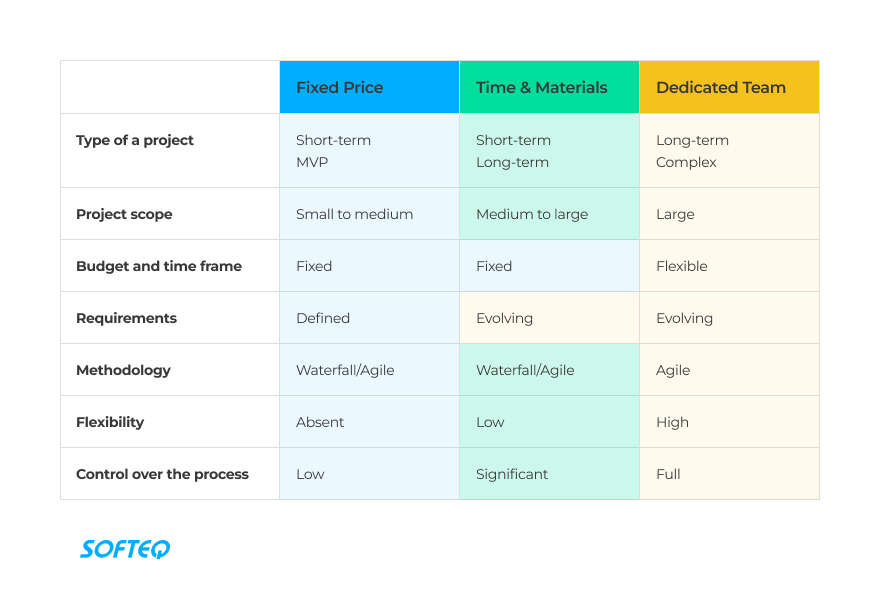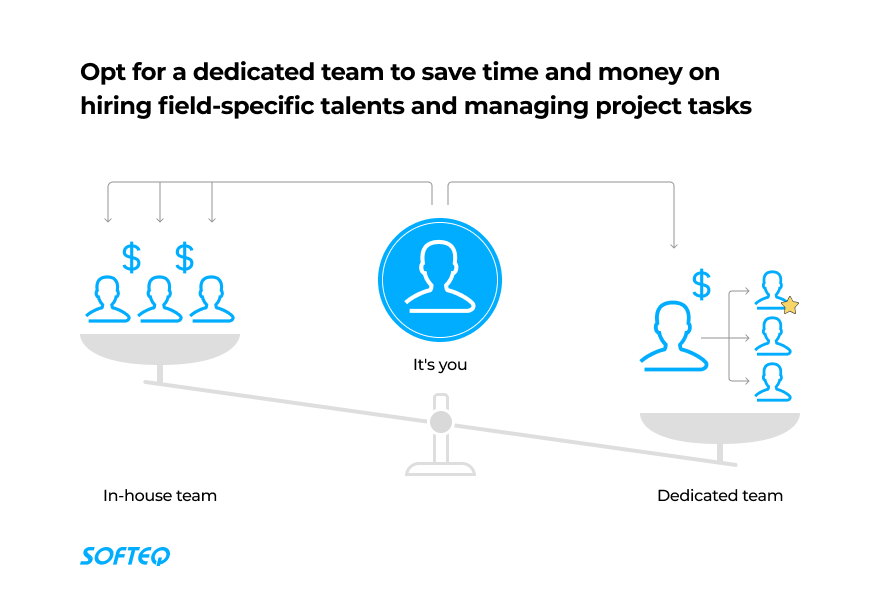3 Scenarios Where the Dedicated Team Model Works Best

“... we may ask for a certain product feature, and as development goes along, we may discover that this product feature might cause us problems or conflicts. Softeq was able to push back with our development team and suggest alternative approaches.”
This is a quote from one of our clients—Mike Brown, the VP of Business Development at Zaps. The dedicated team of developers from Softeq have contributed to Zaps’ project development. In this instance, Zaps got relevant skills and expertise for their solution and a flexible approach. But the dedicated team model can offer even more benefits.
Table of Contents
The Dedicated Team Model in Brief
A dedicated team is a group of remote specialists you hire to build a new solution or contribute to your ongoing project. You may want to choose a dedicated team model when you have a long-term project with a flexible time frame and you need to control the process. This can be a good choice for both fast-growing startups and mature enterprises.

Key benefits of the dedicated team model include:
- Delegated management. The dedicated team comes with experience in IT project management. The team can take over a project, select the best-suited technologies, and control the progress. They can offer their own management practices and frameworks and you can choose the team’s level of independence in these aspects.
- Relevant experience and expertise. You get access to professionals with relevant expertise in narrow fields. They can be specific specialists like embedded engineers or developers using hard-to-find programming languages.
- Flexibility in project requirements, price, and staffing. For instance, you can choose the team’s size, composition, and competencies. Outsourcing can also fulfill your needs for a particular season or event, like marketing specialists for a product launch.
- Tight collaboration. The dedicated team is a third-party service provider that works like an in-house team. They’re fully dedicated to your project and work in tandem with your team. What’s more, they may have experience with similar projects in the past and a deep understanding of your business domain, competitors, and market.
- Significant savings. Hiring an in-house team of developers rather than outsourcing will cost you more. You can also save resources on staff and management to focus on building the product.
To find your ideal working model, take a look at how we work and which approaches we offer. Keep reading to discover three real example situations from our portfolio where a dedicated team of developers was most suitable.
Scenario 1. You’re a Post-Seed Startup with a Plan to Scale
Once you’ve found a strong market fit, it’s time to scale up. You may need to improve your existing functionality or develop new features. Your MVP may also have issues that affect its performance, meaning the solution doesn’t work in the way you wanted it to.
You might not have enough people power to scale right now, but there are two possible solutions. One is to extend your in-house team, which can be costly and redundant if you don’t need more people permanently. The other solution is to hire a third-party service provider to cover your needs, and this is where the dedicated team model of collaboration suits best.
In this case, a dedicated team can augment your existing team with design, engineering, and QA capabilities. You can choose the team’s composition and competencies and be sure they are fully dedicated to your project. What’s important is that the dedicated team of developers can help you tap into new tech expertise. This approach will help you build a team quickly, save money on hiring, and release the upgraded product faster
Real-world example. Happiest Baby invented SNOO, a smart bassinet that detects crying with the help of sound sensors. It automatically calms babies. The company was looking for a full-stack development company that could help create a complete IoT ecosystem in the bassinet. The dedicated team model was most suitable here.
Softeq operated as an extension of Happiest Baby’s team. We worked on firmware and an app to enable parents to watch their baby via a mobile phone. With our help, it’s now possible to update firmware and mobile apps over the air.
This project is long-term, and after its successful market release, we’ve continued to help with SNOO’s next updates.

Scenario 2. Your Project is Complex and Long-term
When your project is short-term and has clear requirements, you just need implementers. A fixed-price model is perfect for such cases. Meanwhile, the dedicated team model is most suitable for complex long-term projects with the potential to expand.
Long-term projects usually have flexible needs and their scope is frequently changing. The dedicated team can take over a project or part of it. It’s more than just implementing tasks. Dedicated teams can offer their approaches and practices, tailor team composition, and select the best-suited technologies.
Requirements can change over time when a project’s scope isn’t strictly defined. But a dedicated team of developers controls the progress and is in charge of results. This approach is feasible for mature enterprises; giants like Apple, Oracle, and American Express regularly hire dedicated teams.
Real-life example. One of our clients is the global leader in flash memory storage solutions. They needed a partner to develop firmware for their products. Our collaboration started as a small outsourcing project with a couple of developers. A few years later, it transformed into a full-fledged offshore delivery center (ODC) with 115 embedded engineers. As a result, Softeq fully built several components and tools, including software models of hardware and tools to visualize model and hardware state.
Our contribution extended far beyond development tasks. Sharing the expertise became vital as the ODC expanded, so we also suggested a custom knowledge transfer and onboarding approach.

Scenario 3. You Lack Skills or Expertise in Specific Areas
Whether you’re a growing startup or large-scale corporation, you may require specific skills in firmware development or a trusted consultant that will guide you through digital transformation. With the dedicated team model, you get access to the top tech capabilities. Plus, it’s easier to work with hard-to-find engineers with highly relevant or unique skills: just turn to the outsourcer that already has them. Such an outsourcer may even suggest specialists who have already worked with similar challenges.
The dedicated team’s composition is designed to fulfill your needs. A typical team includes different roles: designers, front-end and back-end developers, project managers, BA, QA, and DevOps. This structure can be tailored depending on the project’s requirements and phase. You can even add more competencies and people power as the project develops.
What’s more, you can also better control expenses. For example, to drastically save budget you can choose a specific location or choose not to hire top-tier engineers.
Real-world example. SanDisk is a global flash memory manufacturer. They needed a solution to relieve developers involved in testing the ready-for-release firmware. One of the main requirements was debugging and optimizing products faster before launch. Softeq already had the expertise of setting up turn-key test labs for several top flash firms.
As a dedicated team, we delivered SanDisk our testing service with automated continuous integration. In this case, the server monitors the changes made in the source code of the product being tested. So we help flash engineers verify the firmware quality early in the process and fine-tune the product before it goes live. And, what’s important is that no engineers are involved directly in this process.
To Sum Up
Working with a dedicated team is the best option for growing startups and mature tech businesses. This model comes handy for long-term projects that have unclear needs and changing scopes. With this model, you can be sure that your outsourced specialists will work exclusively on your project. Besides technological expertise, they can bring their approaches and practices. You can also expect proven expertise and experience with similar projects from your knowledgeable providers.
What about time and money? A dedicated team can be more time-efficient than an in-house team hired locally. This is because you can delegate headhunting and task management processes. You can also save money when choosing professionals from non-top-tier locations—but this doesn’t mean you won’t have access to people with exceptional talent and relevant skills.
More articles on the topic






